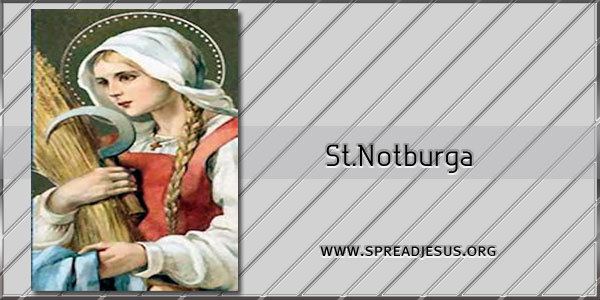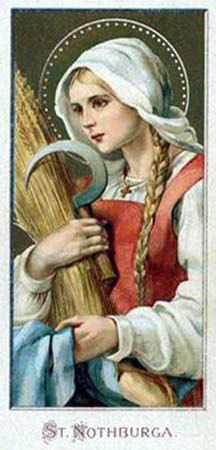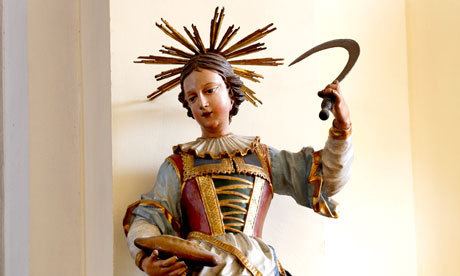Name Saint Notburga Patronage servants and peasants | Feast September 14 | |
 | ||
Attributes ear of corn, or flowers and a sickle in her hand; sometimes the sickle is suspended in the air Died September 16, 1313, Buch in Tirol, Austria | ||
Venerated in Roman Catholic Church Major shrine St. Rupert near Eben | ||
Saint Notburga (c. 1265 – September 13, 1313), also known as Notburga of Rattenberg or Notburga of Eben, was an Austrian saint from modern Tyrol. She is the patron saint of servants and peasants.
Contents

Life

Notburga was a cook in the household of Count Henry of Rattenberg, and used to give food to the poor. But Ottilia, her mistress, ordered her to feed any leftover food to the pigs. To continue her mission, Notburga began to save some of her own food, especially on Fridays, and took it to the poor.

According to her legend, one day her master met her and commanded her to show him what she was carrying. She obeyed but instead of the food he saw only shavings, and instead of wine, vinegar. As a result of Notburga's actions, Ottilia dismissed her, but soon fell dangerously ill. Notburga remained to nurse her and prepared her for death.

Next, Notburga worked for a peasant in Eben am Achensee, on the condition that she be permitted to go to church evenings before Sundays and festivals. One evening her master urged her to continue working in the field. Throwing her sickle into the air she supposedly said: "Let my sickle be judge between me and you," and the sickle remained suspended in the air.
In the meantime, Count Henry had suffered difficulties, which he ascribed to his dismissal of Notburga, so he rehired her. Shortly before her death she is said to have told her master to place her corpse on a wagon drawn by two oxen and to bury her wherever the oxen stood still. The oxen drew the wagon to the chapel of St. Rupert near Eben, where she was buried.
Veneration
Notburga's cult was ratified on March 27, 1862, and her feast is celebrated on September 13. She is usually represented with an ear of corn, or flowers and a sickle in her hand; sometimes the sickle is suspended in the air.
